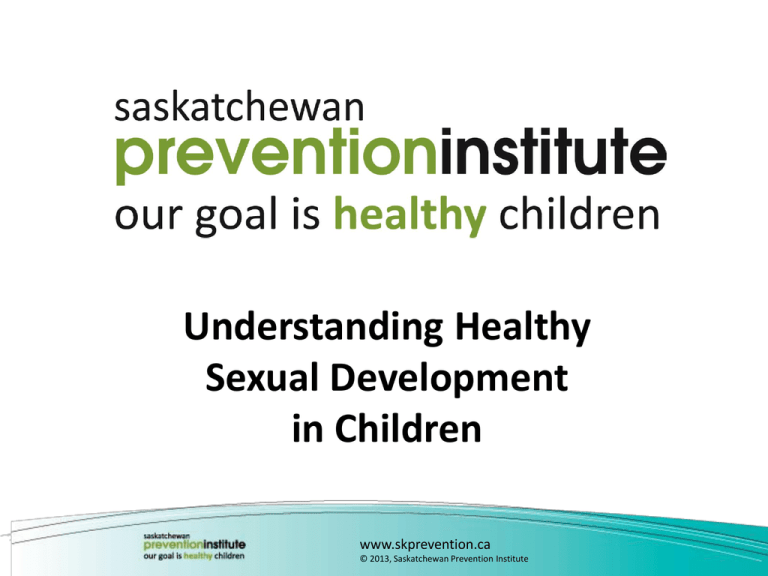
Understanding Healthy
Sexual Development
in Children
www.skprevention.ca
© 2013, Saskatchewan Prevention Institute
OUR MISSION
Our mission is to reduce the occurrence of disabling conditions in
children.
The Saskatchewan Prevention Institute focuses on Primary Prevention:
• Education
• Information Services
• Community Development
• Research and Evaluation
• Communications
www.skprevention.ca
© 2013, Saskatchewan Prevention Institute
PARTNERS IN PREVENTION
•
•
•
•
•
Government of Saskatchewan
Kinsmen Telemiracle Foundation
Saskatchewan Abilities Council
University of Saskatchewan
Community-at-Large
HISTORY
The Saskatchewan Prevention Institute was formed in 1980 as a non-profit,
provincial organization.
www.skprevention.ca
© 2013, Saskatchewan Prevention Institute
PROGRAM AREAS
•
•
•
•
•
•
•
Alcohol, Tobacco, and Other Drugs
Child Injury Prevention
Early Childhood Mental Health
Maternal and Infant Health
Parenting Education
Program Partners
Reproductive Health
www.skprevention.ca
© 2013, Saskatchewan Prevention Institute
Introduction
Sexual health development,
including sexual health
behaviours, is part of
normal child development.
www.skprevention.ca
© 2013, Saskatchewan Prevention Institute
Introduction
Parents’ role as
primary sexual
health educators
of their children is
vital in the
development of
informed and
confident young
people.
Introduction
There is a need for
parents to introduce
sexual health education
at an early age. This
increases the confidence
and comfort of parents
and children to talk
about sexual health
when the children grow
to become adolescents.
Role of Healthcare Professionals
Healthcare professionals
can provide support for
parents to understand
children’s sexual
development.
Role of Healthcare Professionals
Healthcare workers have
the responsibility to
provide accurate
information and positive
guidance in ways that are
developmentally
appropriate for young
people.
Remember:
The building blocks of
sexual health are laid
throughout childhood.
Saskatchewan
Prevention
Institute has
developed
resources for
parents and
health
professionals’
use, to promote
healthy sexual
development of
children.
Birth - 2 Years
Normal Sexual
Development
• Explores own body,
including genitals.
• Enjoys touch as well as
skin to skin contact.
• Likes to be naked.
www.sexualityandu.ca/parents
www.nctsnet.org
2-5 Years
Normal Sexual
Development
• Identifies self as a boy
or a girl.
• Is curious about the
genitalia of peers and
adults of the same and
opposite sex.
www.sexualityandu.ca/parents
www.nctsnet.org
5-8 Years
Normal Sexual
Development
• Begins to participate in
curiosity based sex role play
with the same or opposite
sex friends.
• Develops sense of gender
identity (understanding that
they are male or female).
www.sexualityandu.ca/parents
www.nctsnet.org
9-12 Years
Normal Sexual
Development
• May undergo physical
changes associated with
puberty.
• May begin to show
emotional, psychological
and social changes
associated with puberty.
www.sexualityandu.ca/parents
www.nctsnet.org
13-16 Years
Normal Sexual
Development
• May become sexually
active.
• May be preoccupied
with body image.
• May be preoccupied
with sexuality (e.g.,
interest in sexual media).
www.sexualityandu.ca/parents
www.nctsnet.org
Important Notes for Parents
• The best time to start communicating healthy
sexual information with your child is in the
early stages of development.
• To become more comfortable with discussions
on sexual development, we encourage you to
visit your local library or bookstores for books
and DVDs.
References
• American College of Obstetricians and Gynecologists. (2005). Teaching
Your Children About Sexuality. Retrieved from
http://www.acog.org/Search?Keyword=sexual+health&Sources=8385ef9c3369-4124-9f01-f31b0b04a89a
• Byers, E. S., Sears, H. A., & Weaver, A. D. (2008). Parents’ reports of sexual
communication with children in kindergarten to grade 8. Journal of
Marriage and Family, 70, 1.
• Chrisman, K. & Couchenour, D. (2002). Healthy Sexuality Development. A
Guide for Early Childhood Educators and Families. National Association for
the Education of Young Children. Retrieved from http://www.naeyc.org
• Klein, J. D. (2005). American Academy of Pediatrics, Committee on
Adolescence. Adolescent pregnancy: current trends and issues. Pediatrics,
116, 281-286.
References
• The National Child Traumatic Stress Network (2009, April). Sexual
Development and Behavior in Children: Information for Parents and
Caregivers. Retrieved from http://www.nctsnet.org/products/sexualdevelopment-and-behavior-children-information-parents-and-caregivers2009
•
The Society of Obstetricians and Gynaecologist of Canada (n.d.). Sexuality and
Childhood Development. Retrieved March 23, 2012, from
http://www.sexualityandu.ca/parents
•
World Health Organization (2006). Defining Sexual Health: Report of a
Technical Consultation on Sexual Health, 28-31 January 2002. Geneva.
Retrieved from
http://www.who.int/reproductivehealth/publications/sexual_health/defining_
sexual_health.pdf
FOR MORE INFORMATION, CONTACT:
The Saskatchewan Prevention Institute
1319 Colony Street
Saskatoon, SK S7N 2Z1
Phone: (306) 651-4300
Email: info@skprevention.ca
Website: www.skprevention.ca








